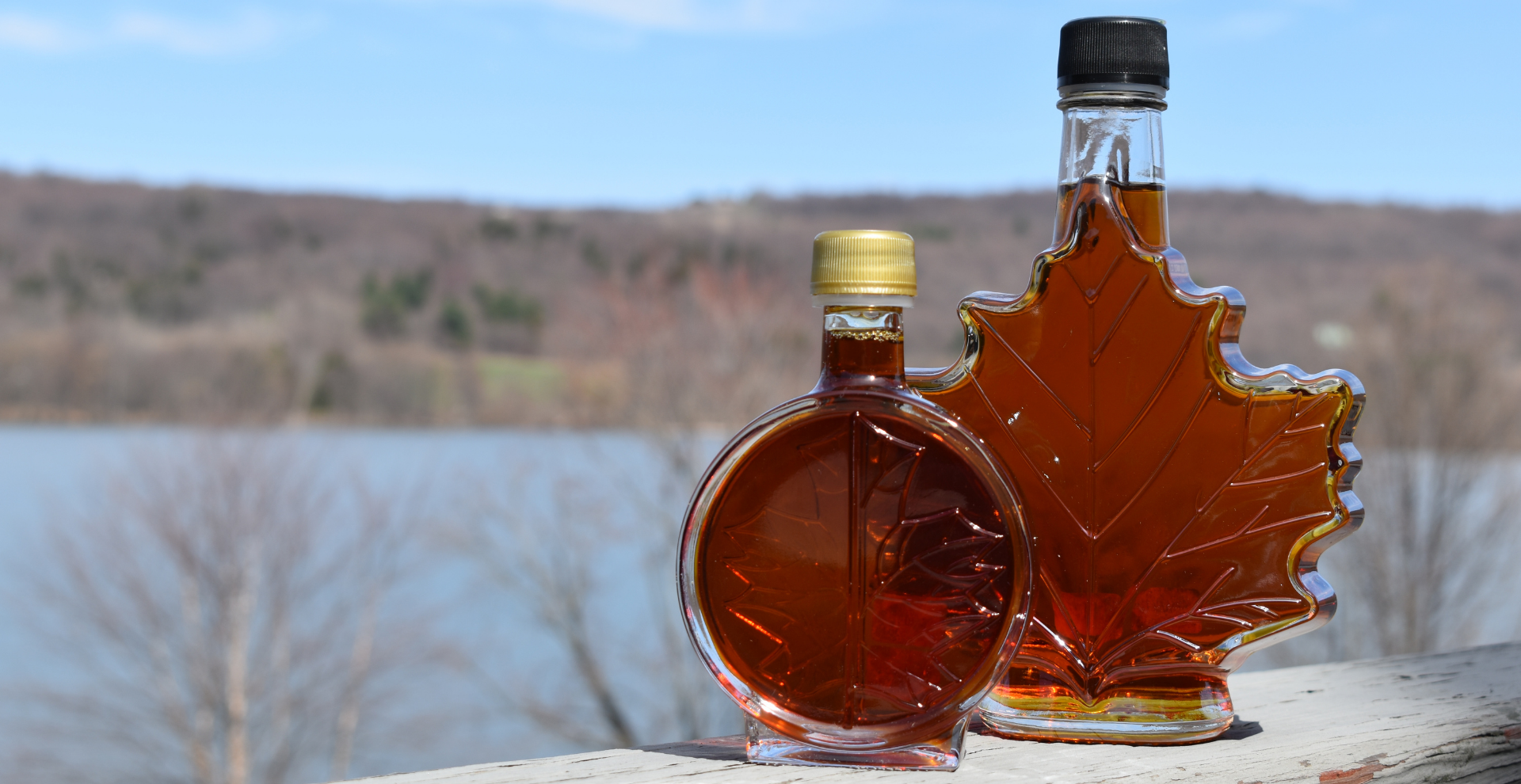

The skinniness surprises me. Unlike the thick-trunked oaks and prickly spruces that come to mind when I think of forests, the maple trees before me looked like tree wannabees. Their branches, naked and narrow, resembled twigs from my backyard — not limbs outstretched from trunks full of sap waiting to be tapped by Cedarvale Maple Syrup Co. in Syracuse, N.Y. Each maple tree along the path stood at a safe and consistent distance from the next, standing tall and straight and reminding me of a bunch of oversized pencils. They appeared unremarkable except for one detail. A network of blue, plastic tubes ferried their collective sap and transported it down the small hill to the sugarhouse, an ancient journey amplified in its sweetness by a growing interest from new practitioners and the COVID-19 pandemic.
For hundreds of years, humans have tapped maple trees from February to the beginning of April as night temperatures drop below freezing and days warm up. Growing up outside Philadelphia, maple farms and the idea of tapping a tree in my backyard escaped me. But this year, my fourth spring in Syracuse, I decided to seek out yet another safe, outdoor activity and visited Cedarvale, a 20-minute Uber from my off-campus apartment. Although the COVID-19 pandemic forced the New York State Maple Producers Association (NYSMPA) to cancel upstate New York’s annual March Maple Weekend, some local farms such as Cedarvale continue to invite families to complete contactless tours through their 1,200 taps (with another 700 across the street) and witness clear, watery sap boil down to a household staple.
In Indigenous history, maple syrup existed as a sacred gift given from their Creator to give the people hope for spring.
My Uber dropped me off in front of a farm-like expanse of small wooden structures. I spotted a few people milling out front where a campfire burned. I thought about ordering hot chocolate or pancakes from the outdoor window but opted instead to begin my tour, heading back toward the forest of maples. I expected a grand operation designed to accommodate throngs of pandemic-weary tourists looking to welcome spring. Instead, I found myself unbothered by fellow maple-seekers, enjoying the solitude and the meditative surroundings that maple-syrup producers tout as a cherished aspect of their sugarmaking.
And more and more long to experience that. Farms such as Cedarvale dot New York state. In fact, a recent survey ranked the state as the second-largest syrup producer in the country based on 2019 productions (only Vermont delivered more sap). Helen Thomas, the executive director at the NYSMPA, says that during her 11 years in the position, New York state maple production has grown about 330%, and membership in the association has nearly doubled. Thomas says exportation contributes to much of this growth, but many local community members experiment with tapping maple syrup on their own. “More people are doing it for income, but there's also just a lot of people doing it for the joy of it, for the fun,” says Sandy Wilcox, owner of her family’s maple syrup equipment store, Countryside Hardware and maple farm in DeRuyter. She also says that they get a lot of grandparents who share the farm’s a great place to bring their grandkids.
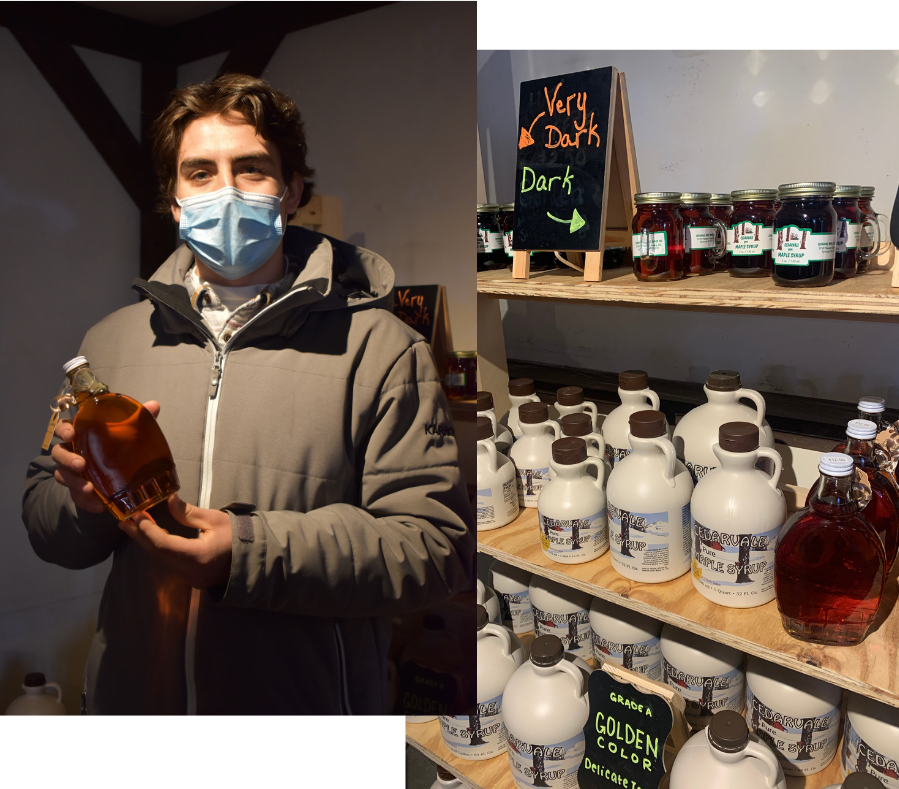
Mike Spicer first fell in love with tapping maple trees after a fifth grade school field trip. A hobby he practiced in his backyard led to an early start to an unexpected career path running Cedarvale Maple Syrup. Photo by Emily Johnson.
Devon Bartholomew and his wife and daughter found the joy of producing maple syrup as a passion project. The Syracuse University Baptist chaplain taps three or four of the maple trees in his backyard, boiling the sap down to syrup on his stove. The hobby of making maple syrup, Bartholomew says, gives him an opportunity to grow and experiment in the process, a way to reflect upon and compare the passage of time, and offers a sense of purpose. The five to six quarts Bartholomew produces each maple season last throughout the year. His daughter likes to stir it into her yogurt, and Bartholomew and his wife use it as sweetener for their tea.
Bartholomew and his family offer a traditional contrast to farms and larger operations that use heavy machinery and tools to eliminate the heavy lifting for sugarmakers. But sweet-seekers such as Bartholomew looking to tap the trees that surround them and who embrace the physical demands of the hobby need very little equipment. Countryside Hardware’s Wilcox says that production costs for an individual range from less than $50 to a few thousand depending on the technology desired. “We deal with any size producer right from the smallest to the largest and there's tools for everybody's size so you don't have to be huge to make maple syrup,” Wilcox says.
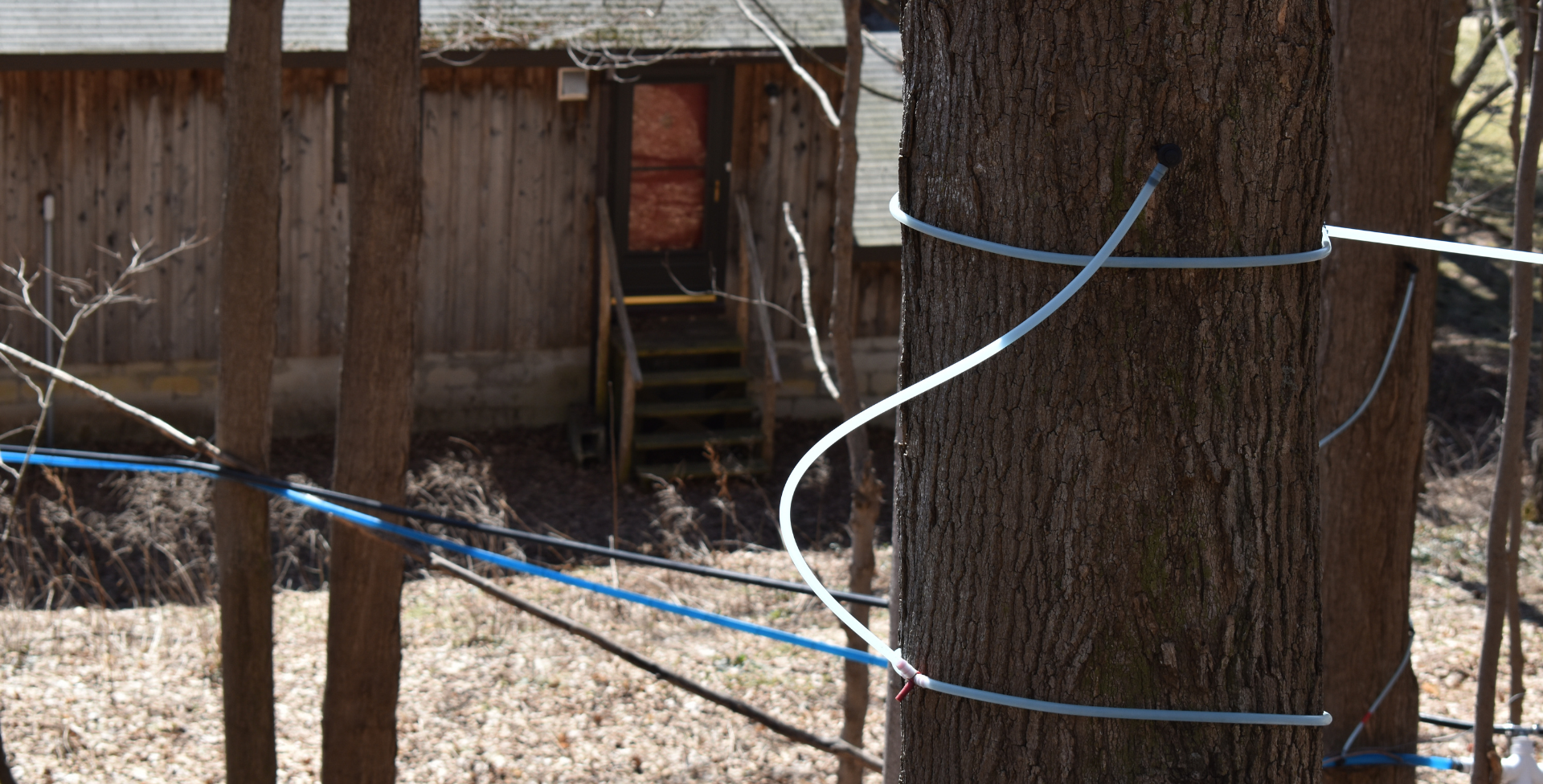
“Maple is a very labor intensive job,” Sandy Wilcox says. Tubing requires maintenance and replacement but saves time and energy throughout the season so that producers don’t have to collect the syrup manually. Photo by Emily Johnson.
With or without up-to-date technology and a team of helpers, turning sap into syrup requires tedious oversight and attention. Drawing sap out of the tree can be done as simply as drilling a spile into the trunk and attaching a bucket to collect sap or as complex as integrating a vacuum system in which lines of tubing connect the trees and a vacuum force pulls the sap out. While I shivered in the early March wind, I listened to the suction of the vacuum, a quiet hissing breaking up the silence, the sound of sugar running through each tree’s veins. Then my eyes followed the tubing down the hill to Cedarvale’s sugarhouse where the reverse osmosis machine and evaporator boils down the sap to eliminate its water content, turning 40 to 50 gallons into one gallon of syrup.
As I looked up at Cedarvale’s evaporator and watched as it pumped out steam, a few new visitors joined me. We listened to Colin Doner, the young guide, explain the breakdown of how syrup is made and waited for the temperature gauge to reach 219 degrees Fahrenheit. The little kids watched as syrup flowed from the bottom of the evaporator into a metal bucket, a stream of cloudy caramel, before being transferred through a filtration system. He pointed to two miniature containers of syrup — one thick and foggy, and the other translucent like the maple syrup that sits on a grocery-store shelf. Cedarvale’s filtration system assists with the syrup’s clarity, refining it, eliminating the cloudiness, and making it a more desirable product for consumers.
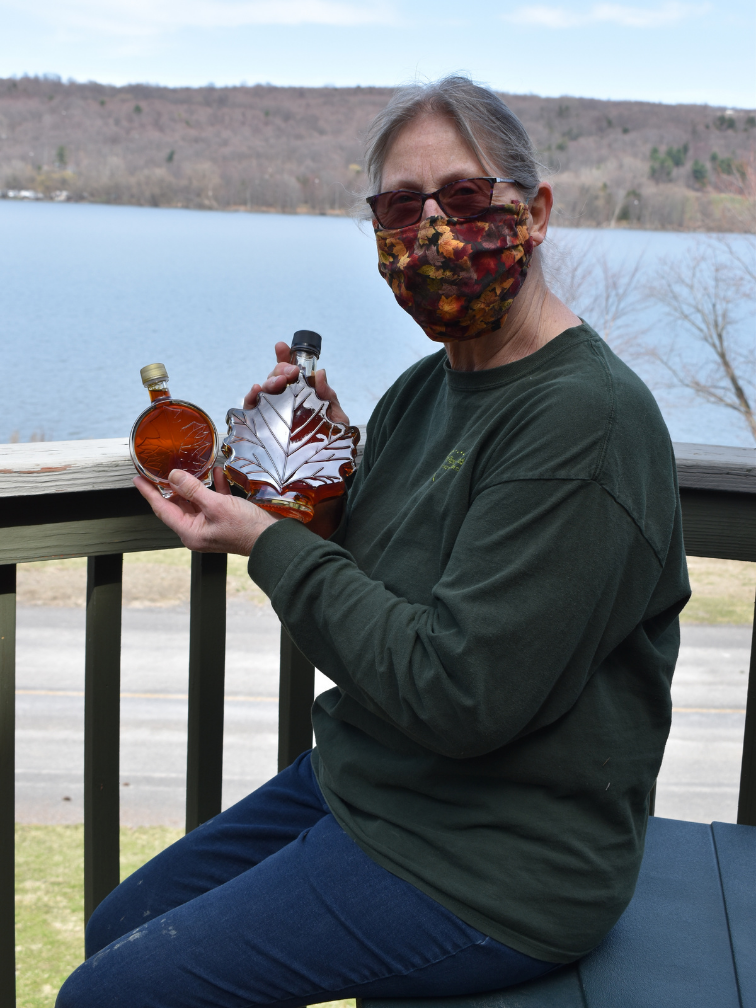
Barb Hamlin was seven years old when her family visited a Vermont sugarhouse. Maple candies, which she remembers sticking to her fingers all day long, now sit in a tupperware in her own sugarhouse ready for kids to experience a similar memory. Photo by Emily Johnson
But the industry seeks to move beyond desirable syrup as the product’s identity as a pancake topper continues to shift. And Aaron Wightman, a maple specialist and co-director of the Cornell Maple Program, hopes to help with that shift. His job involves diversifying maple’s use and testing concepts, recipes, and processes for maple farms. “Maple producers can then pick up what we've done, all that homework we've done, and develop new products, like we're working on maple chocolate, maple wine, maple beer, kombucha, things like that,” he says. “A household might buy a jug of syrup, and it sits in a refrigerator for four months, but they might come back and buy another maple product if we're offering different things.”
Standing in front of the rows of maple syrup in Cedarvale’s sugarhouse store, I admired the shades of colors ranging from golden, amber to dark brown, each shade revealing when in the season it was tapped. The later in the season, the darker the syrup produced, Bob MacGregor, forest properties director at SUNY College of Environmental Science and Forestry, says.
With his grey jacket zipped to the top and a bit of flannel peeking through, Michael Spicer roamed around the gift shop. Spicer, a Hamilton College economics student, started tapping maple trees at age 11 before assuming Cedarvale’s operations from Karl Wiles in 2019. He now carries on Wiles’ legacy of more than 40 years. Spicer helped his mom check out customers at the counter as an older employee helped a visitor work out how to integrate maple syrup into recipes and store large quantities at home. Just as I reached for a syrup with alleged butterscotch undertones, I remembered the half-full bottle in my kitchen. Syrup, I thought, I didn’t need. Then I noticed a line of pancake mix bags. Banana caramel? Sold.
Barb Hamlin, owner of Pied Piper Maple Products and purveyor of maple popcorn, nuts, sugar, and cream, knows the value of all things maple-related. She also owns a maple farm that sits on 29 acres of land, 350 feet of which look onto Otisco Lake. Hamlin started producing maple syrup back in 2007 before buying equipment in 2009, but recalls loving maple syrup since her family visited Vermont when she was seven.
New York state maple production has grown about 330% in 11 years, and membership in the New York State Maple Producers Association has nearly doubled.
She led me up to a small sitting room and kitchen and spoke of her time in the late 1970s at SUNY ESF, where she created and copyrighted a short film about producing maple syrup. Before any objections, Hamlin loaded the film into her DVD player and then began making maple tea. The first course in what would become a maple meal of maple cream, maple cashews, and maple candies. As the final credits rolled, Hamlin reflects on how much has changed surrounding maple production since then, including the length of maple season.
Hamlin says this maple season was her shortest yet, ending just before my visit to Pied Piper in early April. “If you look up at the maple trees right now,” she tells me, “you can see that the buds are swollen. And once the buds are swollen, you would get really bitter syrup.” This year the weather turned too warm and stayed too warm to produce saleable syrup, but researchers and scientists continue to monitor how climate change may affect maple season. Steve Gabriel, a specialist at Cornell’s Small Farms Extension Program, reported to Syracuse.com: “What I’m noticing with climate change is that we’re getting a really extreme change in when the first tapping happens.” An earlier end to winter may sound enticing, but the impact on sap’s sugar content and sap flow may prove problematic in years to come.
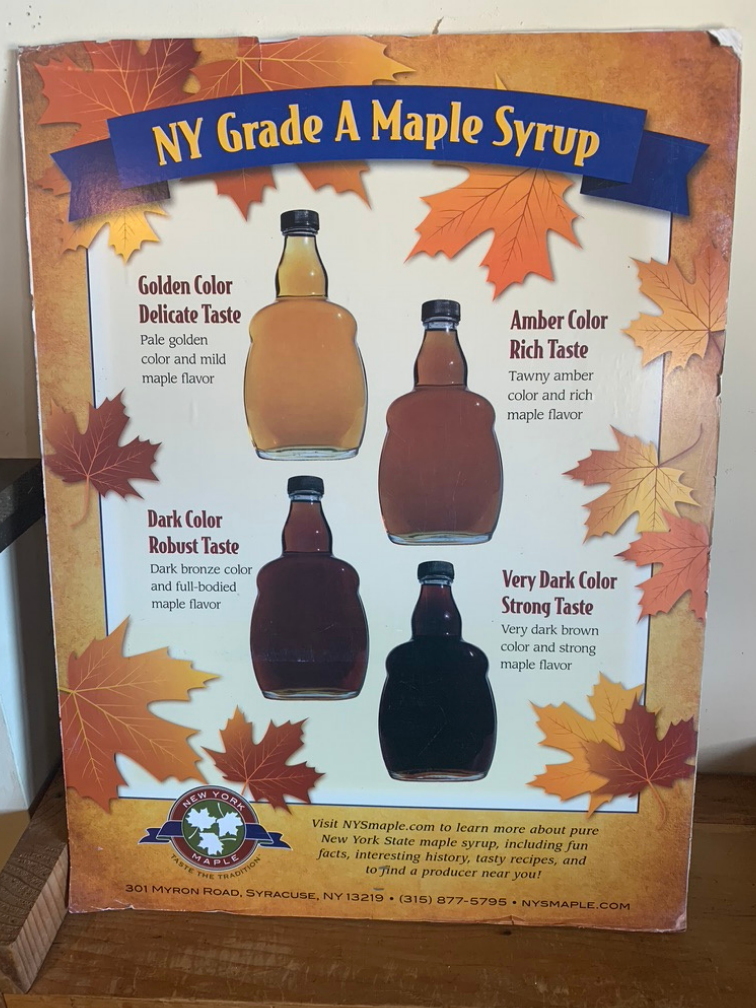
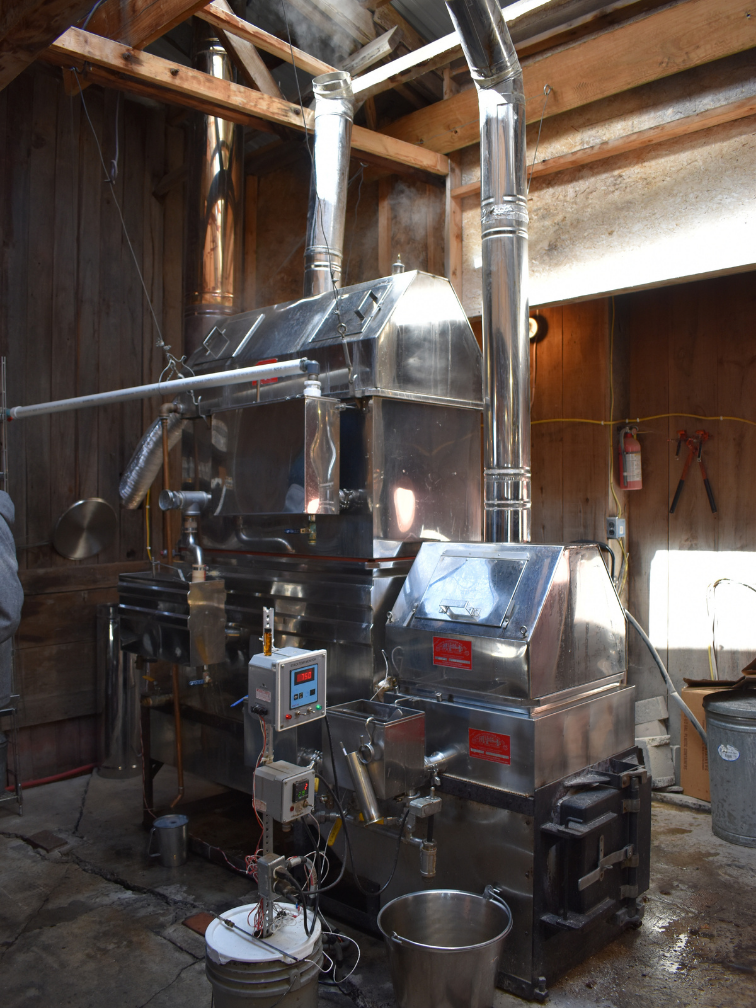
The shade of maple syrup depends on when the tree is tapped during the season, says Bob MacGregor of SUNY-ESF. The beginning batches produce lighter color syrup while syrup from later in the season turns darker as the weather gets warmer. An average sap collection is 98% water and 2% sugar, Sandy Wilcox says. A reverse osmosis machine, if used, removes around 75% of the water before an evaporator finishes the job. Photos by Rachael Rosenthal and Emily Johnson.
Aside from the sugar high Hamlin’s sugar snacks gifted me, Pied Piper’s integration of maple into a range of products parallels the use of maple in the health foods market. Recipes calling for less processed ingredients and consumers continuing to educate themselves on decoding nutrition labels transformed maple syrup from a pancake topper to a superfood. “The key buzzwords that we have for maple are sustainable, natural, locally produced, and clean label,” says Cornell’s Wightman. “And clean label's a big buzzword in the food products industry to describe ingredients that when people look at the ingredients, they know what it is, rather than seeing some chemical that they don't understand what it means, they see just a plain natural product in the ingredient list.”
But despite the healthy buzz bestowed upon the syrup, Maria Erdman, a registered dietician and associate professor at Syracuse University, advises moderation. In fact, Erdmans cautions those who want to put a nutritional halo on maple syrup, pointing out that although it includes amounts of vitamins and minerals, that doesn’t make it a sweet superstar. “It's still a carbohydrate that is going to be absorbed into your body and act mostly in the same way that any other sugar sucrose will,” Erdman says. “But you will also have these added benefits, possibly of manganese, thiamine and some of these polyphenols.”
Maple syrup in its pure form, without a list of added ingredients found on the back of a bottle of Mrs. Butterworth’s, can serve as a narrowly healthier alternative to white sugar. But Erdman warns that “adding it in as an extra on top of what you're already eating is probably not going to really do you any good.”
Beyond nutrition, Wightman points out that maple syrup production is more sustainable because it doesn’t disrupt the surrounding ecosystem or produce pollution compared to other sugar options such as high fructose corn syrup and cane sugar. Adam Wild, Wightman’s co-director at Cornell’s Maple Program and director of the Uihlein Maple Research Forest, says when a syrup producer properly taps the trunk, the tree suffers no more harm than you would to donate blood.
“The sugars that we're taking from the tree are just a small portion of a reserve of storage sugars that they have. Maples do store and reserve a lot of sugars in case they need it,” Wild says. “We do realize the value in the forest that we have and if we're not actively maintaining that and the health of the trees, then, you know it's not going to be there to continue to tap in the future.” Hamlin even bottles Pied Piper’s syrup in glass containers and offers a $1 discount for those who return the bottles in an effort to encourage environmentally-friendly practices.
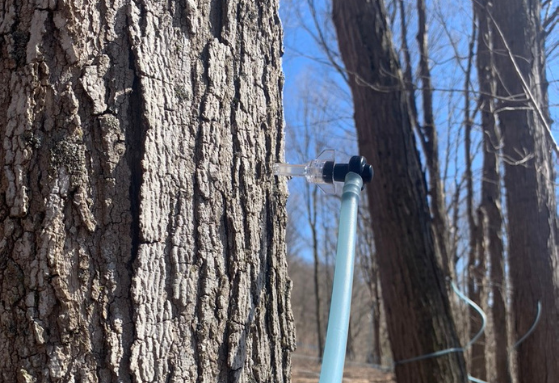
To properly maintain the health of maple trees, spiles cannot be drilled into the tree in the same location every year. Photo by Rachael Rosenthal.
Those earth-focused features also appear in maple syrup’s origin story. In Indigenous history, maple syrup existed as a sacred gift given from their Creator to give the people hope for spring, and Indigenous people are recognized for tapping the first maple trees in the 1600s. Doug George-Kanentiio, author and member of the Mohawk Nation of the Haudenosaunee Confederacy, tells of how the Creator taught the people how to tap maple trees respectfully and easily. But the people took advantage of the maple, and the Creator came back to see they had abandoned their duties and abused the sugary syrup. “The Creator was not too pleased and said that, well from here on out, you will have maple syrup. But you got to work for it,” George-Kanentiio says. “And not only do you have to work for it, you have to do these ceremonies that will be taught to you in order to retain some sense of gratitude and humility.”
Today, Indigenous communities celebrate maple season through an annual one-day maple ceremony during the second week of April, one of 13 ceremonies recognized by the Haudenosaunee Confederacy. George-Kanentiio also recognizes the contrast between the Indigenous relationship with maple and an industry that continues to industrialize the practice and product. “We see all the evaporators and osmosis machines, and pumps and hoses that they use,” George-Kanentiio says, who laments the sight of those blue lines of tubing crisscrossing a maple forest. “They've lost completely the spiritual essence. They don't treat it as something sacred. They treat it as something like oil or natural gas.”
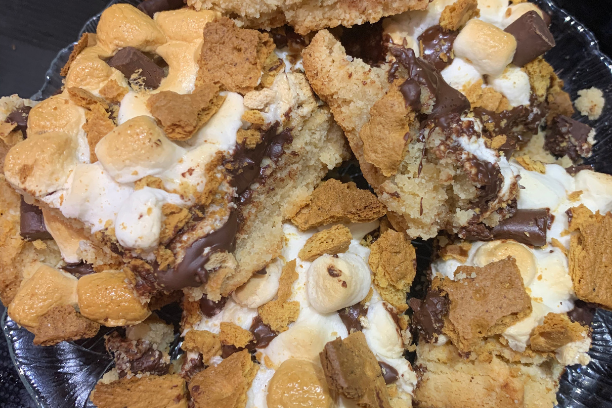
Big, gooey, and gone in minutes, these s’mores bars earn go-to-staple status thanks to their ease and short ingredient list. View Recipe
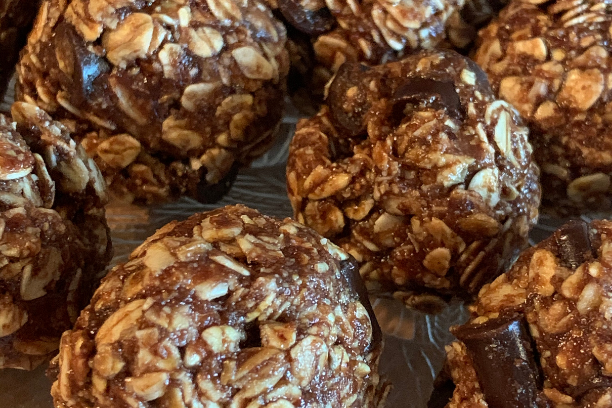
These grab-and-go alternatives to granola or protein bars offer all the energy minus the excess processed sugars in their snack cousins. To pump up your snack jams, add cacao powder and a handful of chocolate chips. View Recipe
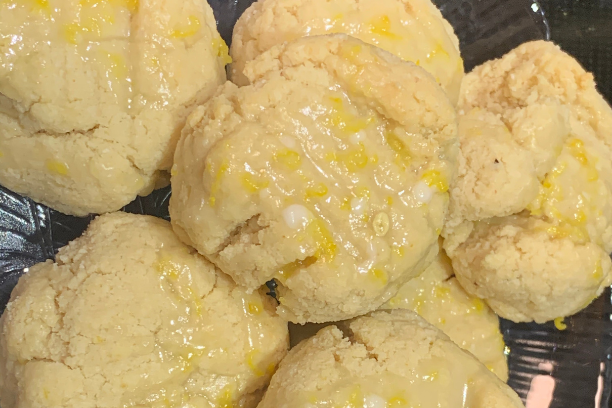
Drizzling the lemon and powdered sugar icing on top of these soft cookies adds a professional touch to a dessert that features a short ingredient list and minimal steps. View Recipe
Properly tapping the trees by not drilling too many spikes into each trunk and avoiding drilling into the same spots every year may not repair the detachment between humans and maple trees, though. “We've been told that one day maples will lose hope and lose their respect for humans,” George-Kanentiio says. “And they're going to disappear, they're going to fade away.”
The modernization of local tradition may instill concern in some about the next changes to come, but hobbyist maple producers such as Bartholomew and local businesses such as Cedarvale serve as a reminder that producing maple syrup still requires a labor of love.
The blue lines I tracked crisscrossing the forest represent more than an appeal to move on from time-honored operations. “We’re trying to modernize a little bit of the sugarhouse but also keep a lot of the old traditional nostalgic ways of doing it because we want to bring everyone the experience of making the syrup,” Cedarvale’s Spicer says.
Weeks after my trip to Cedarvale, on a sunny morning before class, I tore open my banana caramel pancake mix and debated whether or not to throw chocolate chips into the mix. Throughout the pandemic, I rediscovered my love for specialty breakfasts, cooking my family’s banana pancakes several days a week. Every weekend growing up my dad made M&M pancakes, standing in pajamas in our kitchen, flipping the messy circles dotted with bleeding, primary colors as my sister and I watched from the counter. Ten years later, a slow morning with a hot, homemade stack of pancakes feels just as luxurious. Except this time as the syrup pools on the plate I think back to those skinny maple trees and thank them for the memory.

Our pursuit of outdoor joy is remiss without the acknowledgement of the occupation of unceded Indigenous land. We are students and journalists working, writing, and living on the land of the Haudenosaunee Confederacy, comprising the Six Nations made up of the Mohawk, Onondaga, Oneida, Cayuga, Seneca, and Tuscarora nations. However, acknowledgement is not enough. Read More.